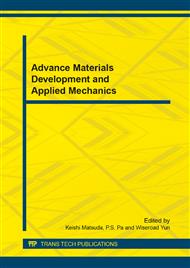[1]
D'Almeida. M. R. J., De Menezes. W. G., and Monteiro. N. S., Ageing of the DGEBA/TETA Epoxy System with Off-Stoichiometric Compositions, Materials Research, Vol. 6 (3), pp.415-420 (2003).
DOI: 10.1590/s1516-14392003000300017
Google Scholar
[2]
Tanaka, Y. and Bauer, R. S., Curing Reactions. in Epoxy Resins Chemistry and Technology, May, C. A., 2nd Ed., Marcel Dekker, Inc., New York, 285 (1988).
Google Scholar
[3]
Norman E. Dowling, Mechanical behaviour of materials, Engineering Methods for Deformation, Fracture, and Fatigue. , Ed. 4th, pp.100-234.
Google Scholar
[4]
Mariam, E.A. (2010), A Study on the Effect of Hardener on the Mechanical Properties of Epoxy Resin, MSc Thesis., University of Technology: Republic of Iraq.
Google Scholar
[5]
Odegard, G.M. and Bandyopadhyay. A., Physical Aging of Epoxy Polymers and Their Composites, Journal of Polymer Science Part B: Polymer Physics, Vol. 49 (24, pp.1695-1716 (2011).
DOI: 10.1002/polb.22384
Google Scholar
[6]
Shaorong. L., Ban. J., Yu. C., and Deng.W., Properties of Epoxy Resins Modified with Liquid Crystalline Polyurethane, Irnanian Polymer Journal, Vol. 19(9), pp.669-678 (2010).
Google Scholar
[7]
Ferreira J.A.M., Costa J.D.M., Reis. P.N.B., and Capela.C., A Study on the Stiffness and Toughness of Enhanced Nanofilled Epoxy composites, Anales de Mecanica de la Fractura, Vol. 1(28), pp.291-296 (2011).
Google Scholar
[8]
Jean-Marie. B, Composite Materials. Mechanical Behavior and Structural Analysis., pp.15-23.
Google Scholar
[9]
S. Grishchuk1, Z. Mbhele2, S. Schmitt1, J. Karger-Kocsis, Structure, Thermal and Fracture Mechanical Properties of Benzoxazine-Modified Amine-cured DGEBA Epoxy Resins, Express Polymer Letters, Vol. 5 (3), pp.273-282(2011).
DOI: 10.3144/expresspolymlett.2011.27
Google Scholar
[10]
Sherman, D. and Brandon, D., Mechanical Properties of Hard Materials and Their Relation to Microstructure, Advance Engineering of Material, Vol. 1, no. 3-4, pp.161-181 (1999).
Google Scholar
[11]
Cuddihy, E., Moacanin, Superposition of Dynamic Mechanical Properties in the Glassy State, Journal of Polymer Science Part A-2(Polymer Physics), Vol. (9), pp.1627-1634(1970).
DOI: 10.1002/pol.1970.160080915
Google Scholar


